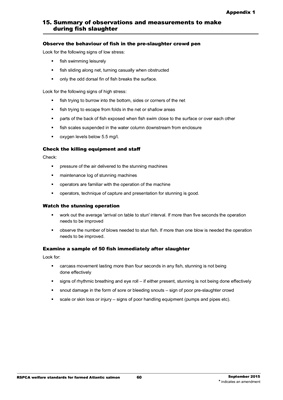
Appendix 1
RSPCA welfare standards for farmed Atlantic salmon 60 September 2015
* indicates an amendment
15. Summary of observations and measurements to make
during fish slaughter
Observe the behaviour of fish in the pre-slaughter crowd pen
Look for the following signs of low stress:
fish swimming leisurely
fish sliding along net, turning casually when obstructed
only the odd dorsal fin of fish breaks the surface.
Look for the following signs of high stress:
fish trying to burrow into the bottom, sides or corners of the net
fish trying to escape from folds in the net or shallow areas
parts of the back of fish exposed when fish swim close to the surface or over each other
fish scales suspended in the water column downstream from enclosure
oxygen levels below 5.5 mg/l.
Check the killing equipment and staff
Check:
pressure of the air delivered to the stunning machines
maintenance log of stunning machines
operators are familiar with the operation of the machine
operators, technique of capture and presentation for stunning is good.
Watch the stunning operation
work out the average 'arrival on table to stun' interval. If more than five seconds the operation
needs to be improved
observe the number of blows needed to stun fish. If more than one blow is needed the operation
needs to be improved.
Examine a sample of 50 fish immediately after slaughter
Look for:
carcass movement lasting more than four seconds in any fish, stunning is not being
done effectively
signs of rhythmic breathing and eye roll - if either present, stunning is not being done effectively
snout damage in the form of sore or bleeding snouts - sign of poor pre-slaughter crowd
scale or skin loss or injury - signs of poor handling equipment (pumps and pipes etc).